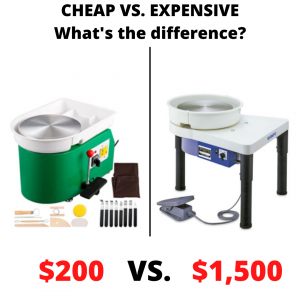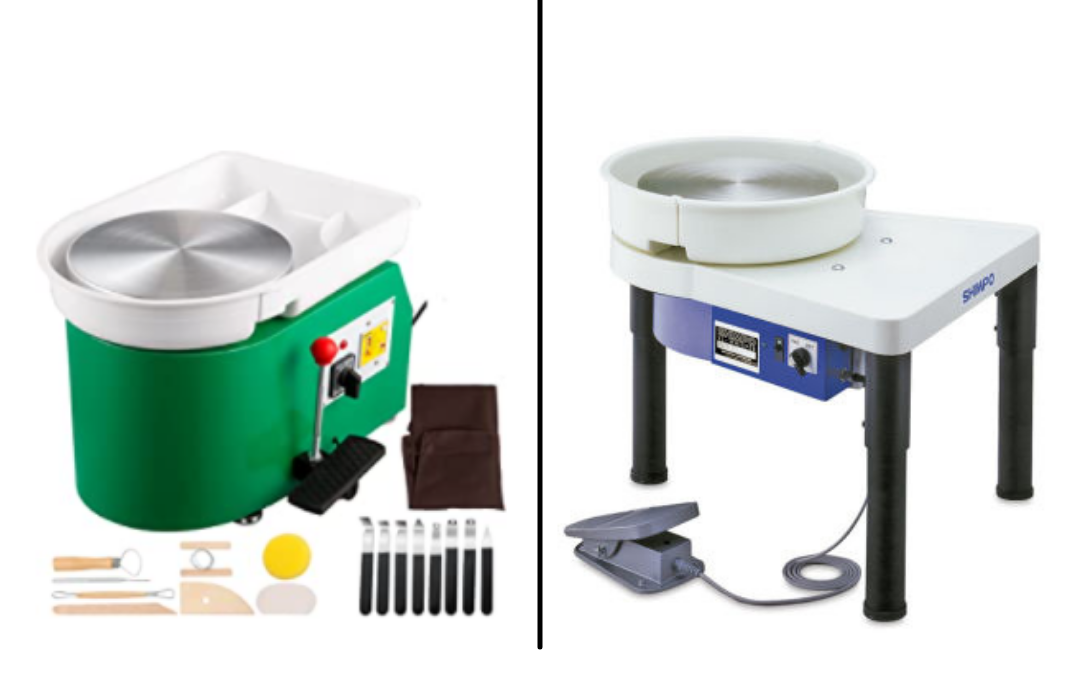
If you’re new to pottery, you might be wondering why it seems like wheels are so expensive. Pottery wheels range in price from $200 to $2,000 or more. Even the low end of this range can seem daunting to someone new – but there’s a good reason for it. Wheels are expensive primarily because of the amount of clay they need to handle – professional wheels can maintain 250 RPM while centering 100+ pounds of clay. This means they need a large motor and a lot of electricity to maintain these speeds. Lower cost wheels can’t handle these weights or speeds, and will slow down after just a few pounds of clay.
The right wheel for you depends greatly on what you’re planning on doing with it. If you’re a hobbyist potter who’s just getting started, an inexpensive wheel might be a good fit. But if you’re planning on making a lot of pots, throwing big, or plan on putting a lot of wear on your wheel – it might be a good idea to get a reliable brand.
So why are some pottery wheels so expensive? Let’s dive in:
How much does a Pottery Wheel cost? What’s the difference between them?
The cost of a wheel can vary significantly. If you look on amazon, the least expensive wheels are in the $200 range. But there’s a catch: Most of these wheels are a poor replacement for a professional wheel, and can’t handle more than a few pounds of clay. High-quality wheels can cost anywhere from $1,300-$2,000. Even budget wheels start at $600 or more. These wheels are made by well regarded brands in the industry, such as Brent, Shimpo, Skutt, or Soldner. Inexpensive wheels can be found online, but they will not last you nearly as long (a good wheel can last 10-20 years), won’t maintain their speed under weights over a few pounds, and are far less reliable.
If you’re planning on buying a good wheel that can last a lifetime, expect to spend around $1,000-$1,500.
What to consider when buying a Wheel?
In addition to choosing a wheel from a reputable brand, the most important things to consider are speed, centering capacity, reliability, and consistency. Professional potters frequently use wheels with heavy-duty motors that can center a significant amount of clay.
Other factors include noise, size and form factor, and weight. Be sure your studio space has both adequate space and a table that can handle the weight – most wheels range from 11″-22″ in height, are 22-26″ wide, and can weigh over 120lbs. The weight of your wheel, clay, and pressure from your body applied when throwing can exceed 300+lbs – so a heavy-duty table or workbench is a must.
What other expenses do potters have?
In addition to the cost of a wheel, there are several other expenses potters have to consider. These include basics like tools and materials including clay and glaze material, as well as firing expenses, studio space, continuing education, and more. For professional potters who sell their work, they also need to budget for application fees for shows, marketing expenses, association memberships, and more.
Tools, Clay, & Glaze costs
Tools, clay, and glaze materials are probably the least expensive part of pottery – for both professionals and hobbyists. Basic tools can be found for $25-30 including sponges, rib tools, trimming tools, and more.
Clay is very inexpensive, especially when bought in bulk. Most potters buy a minimum of 50lbs of clay – and professionals will buy 1,000lbs or more at a time. Depending on the type of clay and amount purchased, this can range from $0.50/lbs to $1.00/lbs.
Glaze materials can range significantly depending on how it’s acquired. Pre-mixed glazes cost $10-$20 per pint – but aren’t customizable.
Glaze materials for mixing your own glazes range significantly in price – from $2.50/lbs for simple materials like Calcium Carbonate, to upwards of $23.50/lbs for materials like Copper Oxide. While these raw materials can be more expensive at first, they cut down on the costs for professional potters in the long run, allowing them to mix their own glazes and experiment with different materials.
Kilns & firing costs
The cost of Kilns and firings is one of the most significant expenses for potters. Most potters don’t own their own kilns, and frequently share firing space with others in their studio to cut down costs.
This is because kilns are expensive! Electric kilns range from $900-$2,500, but most professionals require more space and are spending around $2,000. Gas kilns can hold significantly more pottery, but get much more expensive. Gas kilns range in price from $8,700-$23,000+.
Most studios will allow students (and occasionally others) to fire pieces in their kilns for a fee. These fees are determined by your local studio – so if you’re curious, call them up and ask! These prices are generally determined by the type of firing (bisque or glaze, electric or gas), size of the pieces, and cone (temperature) the kiln is fired to. These prices vary significantly, so I’d advise contacting your local studio if you’re interested, but expect to pay at least $1.25/inch of firing space – ex: If your pieces take up 25 sq. inches of kiln space, your firing fee would be around $31.25.
Pottery lessons, classes, and books
Another expense to consider when beginning pottery is education. Beginning potters will benefit significantly by taking classes. Many studios offer classes from beginners to advanced lessons, and costs range from $20-$40 per class, or $150-250 for a 6-8 week course.
Most potters also invest in books, from glaze recipes to techniques – to help master their skills.
Some even pursue a degree in ceramics – but that’s less common. Most potters agree that the best way to learn is through apprenticeships and mentorship programs.
Conclusion
Pottery can be expensive – but can also be well worth it! Even if you’re just starting out – costs can be reduced significantly by participating in local classes, which often include access to studio space, wheels, and firings. Professional potters take on each of these expenses on their own, or share them with studio mates – so keep that in mind the next time you consider the price of a handmade mug!

